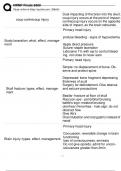NRNP Finals 6560
Study online at https://quizlet.com/_99bk2x
Dual impacting of the brain into the skull;
coup injury occurs at the point of impact;
coup-contrecoup injury
contrecoup injury occurs on the opposite
side of impact, as the brain rebounds.
Primary head injury
profuse bleeding - signs of hypovolemia
Scalp laceration: what, effect, manage-
ment Apply direct pressure
Suture/ staple laceration
Lidocaine 1% with epi to control bleed-
ing, not close to nose/ ears
Primary head injury
Simple: no displacement of bone. Ob-
serve and protect spine
Depressed: bone fragment depressing
thickness of scull
Surgery for debridement. Give tetanus
Skull fracture: types, effect, manage- and seizure precautions
ment
Basilar: fracture at floor of skull
Raccoon eye - periorbital bruising
battle's sign: mastoid bruising
otorrhea/ rhinorrhea - halo sign: do not
obstruct flow
Give Ab's
Oral intubation and oral gastric instead of
nasal
Primary head injury
Concussion: reversible change in brain
functioning
Brain injury: types, effect, management
loss of consciousness, amnesia
Do not give opioids, admit for uncon-
sciousness greater than 2min
, NRNP Finals 6560
Study online at https://quizlet.com/_99bk2x
Contusion: bruising to surface of brain
with edema
Frontal and temporal region
Brainstem contusion: posturing, variable
temp, variable vital signs
N/V, dizziness, visual changes
seizure precautions
Epidural hematoma: commonly tempo-
ral/ parietal region with skull fracture,
causing bleeding into epidural space
Loss of consciousness
Rapid deterioration: obtunded, contralat-
eral hemiparesis, ipsilateral pupil dilation
CT scan (non contrast)
Treatment based on Brain trauma foun-
dation. Surgical if greater than 30cm
Hematoma - neuro: types, effect, man-
Subdural hematoma
agement
most common type of intracranial bleed
Acute (hours): drowsy, agitated, con-
fused, headache, pupil dilation,
CT scan (noncontrast)
surgery for 10mm thickness or 5mm mid-
line shift or for worsening GCS
Chronic (days): headache, memory loss,
incontinence
CT scan (noncontrast)
Surgery: burr holes/ crani
decreased level of consciousness
Blown pupil
Cerebral edema/ ICP elevated/ hernia- Cushing triad: HTN (widening pulse
tion: symptoms, management pressure), decreased resp rate, brady-
cardia (means increased intracranial
pressure)
AVPU: awake, response to verbal stimuli,
painful stimuli, unresponsive
Neuro exam components
GCS: 8 or below is comatose
, NRNP Finals 6560
Study online at https://quizlet.com/_99bk2x
Posturing:
decorticate = arms, legs in
decerebrate = arms, legs out
Hyponatremia: SIADH and cerebral salt
Electrolyte imbalances in brain injury wasting
Hypernatremia: DI (give mannitol)
- Consult neurosurgery
- Limit secondary injury
- Prevent hypotension (syst 90) and hy-
poxemia (PaO2 60). May give blood to
improve tissue perfusion.
- Treat cerebral edema: elevate bed, se-
date, paralyse, mannitol, hyperventila-
tion (PaCO2 25-30), during first 24hrs.
- sedation and analgesia: opioids to re-
duce ICP (Fentanyl) with propofol. Could
give Nimbex or Vec. to help oxygenate/
ventilate
- steroids: avoid
Management of traumatic brain injury
- Give mannitol or hypertonic saline for
herniation: bolus then gtt. monitor serum
osmolality, sodium, and bp.
- Seizure precautions: give phenytoin or
keppra
- DVT prophylaxis: stockings, LMWH
- head injury means spine injury until
proven otherwise
- hypothermia: can control ICP (89 - 91F)
- decompressive crani: ICP refractory to
tx
- brain O2 monitoring (jugular vein O2
sats)
For: GCS 3-8 with abnormal CT and co-
matose pt's with normal CT and older
than 40, posturing, hypotension.
Normal value: 5-10 mmHg
, NRNP Finals 6560
Study online at https://quizlet.com/_99bk2x
Recommend initiating treatment if ICP >
20 mmHG.
ICP monitoring
Can calculate CPP (CPP = MAP - ICP).
Should be 60
Must have all:
No spontaneous movement
Absence brain stem reflexes (fixed/ di-
lated pupils, no corneal reflexes, absent
doll's eyes, absent gag, absent vestibular
response)
Absence breathing drive/ apnea
Brain death criteria
can't be declared brain dead when:
hypothermia, drug intoxication, severe
electrolyte/ acid-base imbalance
EEG, CTA of brain, Cerebral angiogra-
phy, transcranial doppler
- MVA, falls, acts of violence, sports,
wounds
- Rapid acceleration/ deceleration caus-
es hyperextension (fall, rear-end colli-
sion)(central cord syndrome), hyperflex-
ion (bilateral facet dislocation), vertical
column loading (compression and then
shattering from falls/ dive lands on butt,
Spinal cord trauma: cause and who at C1 from diving), whiplash
- Distraction injury: from hanging
- penetrating trauma: from wound
- pathologic fractures (osteoporosis/ can-
cer)
mainly cervical spine. High mortality.
More common in men
more common in young than old




